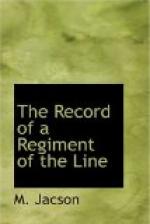Very early in the morning a train had been seen coming out from Machadodorp with reinforcements. These, it was ascertained, were the Johannesburg Police, to the number of about eighty, and they formed the garrison of the kopje, about a hundred more being in the farm behind the kopje. This kopje was a small hill covered with large boulders. The rocks had been connected with large stones to form sangars, behind which the garrison found cover. A pompom was included in the armament of the position, which measured about eighty yards by forty yards only. It fell away abruptly in the rear, the farm and outbuildings lying very close under the steep rear side of the hill.
The English shells fell with terrible accuracy into the sangars, and there was an almost continuous explosion on the hill. Yet the Boers kept up their fire till the Rifle Brigade were within ten yards of them, and their pompom was in action, although partly jammed and firing single shots, till the very end. This pompom was bravely served by one man, the remainder of the gun team having been either killed or wounded. It is not known whether this plucky fellow survived or not.
General Walter Kitchener, who was commanding the infantry attack, decided to attack with the Rifle Brigade along the ridge which ended in the kopje, which was slightly above the level of the ridge. At the same time he ordered the Inniskilling Fusiliers to attack over the low ground on the Rifle Brigade’s right, whilst the Gordon Highlanders and the Devonshire Regiment were held in support.
The Rifle Brigade started from the foot of the hills under which they had taken cover, and which was about 1200 yards from the Boer position, and almost immediately came under heavy musketry fire, being much exposed on the high open ridge.
They, however, continued their advance in perfect order and eventually rushed the kopje, the British shells dropping and the Boers firing till the assault had been delivered. The Inniskillings advanced across the low ground underneath the Rifle Brigade. Their advance was slightly delayed, and their delivery of the assault was consequently later than that of the Rifle Brigade. Captain Emerson with one company of the Regiment which had been told off as escort to the Maxim guns, advanced with the leading company of the Inniskillings.
The whole Boer position was evacuated as soon as their line had been penetrated by the capture of the Bergendal Kopje.
The casualties amongst the Rifle Brigade were severe, owing to the much exposed ground over which it was necessary for the attack to be delivered, and to the fact that, as the extended lines converged on to the small kopje, the men naturally became crowded and formed a better mark for the Boer rifles. They lost two officers and fourteen men killed and five officers and fifty men wounded, of whom two officers died of their wounds the following day. The Regiment had one man wounded.




